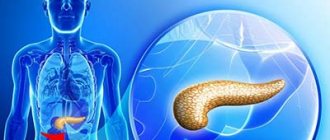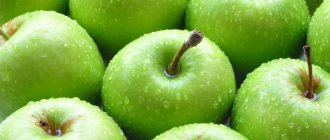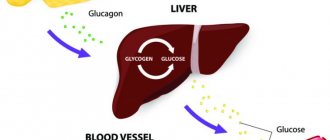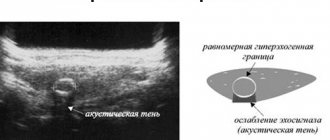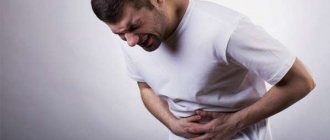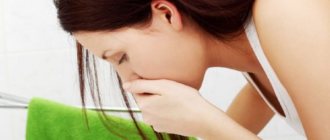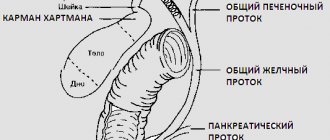The structure and role of the pancreas
The gland consists of:
- upper part (head);
- bodies;
- tail
At the initial stage, inflammation of the extreme part of the pancreas occurs . The process of inflammation of the pancreas is pancreatitis. Usually pain in this area is associated with this disease.
The pancreas produces enzymes responsible for the stomach's digestion of fats, carbohydrates, and proteins. Produces insulin, which is responsible for blood sugar levels. Pancreatic diseases are classified as a dangerous group.
It is difficult to recognize the disease; the symptoms are similar .
Pain syndrome occurs in the upper abdomen and can intensify and cover the entire abdominal cavity. During attacks, the pain will radiate to the back, under the shoulder blade. To avoid exacerbations, avoid alcohol, fatty, and spicy foods.
Types of pain in the pancreas and diseases associated with it
The nature of the pain depends on the causes of its occurrence:
- Pain in the right hypochondrium indicates problems with the liver.
- Girdle pain, in which acute attacks can radiate to the back or shoulder blade, is inflammation of the gallbladder.
- The pain starts from the solar plexus and goes to the back, sharp pain under the right or left hypochondrium are signs of pancreatic inflammation. This pain increases when lying down (usually at night).
- Cutting pain in the upper left abdomen and solar plexus with blue discoloration around the navel indicates damage to the spleen.
- Attacks of stabbing and cutting pain throughout the abdomen, indigestion (diarrhea or colitis), drops of blood in the stool - disruption of intestinal function.
- Aching pain in the left abdominal region and bouts of vomiting - gastric syndrome.
- Acute pain in the lower abdomen, radiating to the navel - appendicitis.
Characteristics and localization of pain
If the left side of the pancreas begins to hurt, then every person should know what needs to be done and where to go for appropriate help. The appearance of dull or acute pain in the epigastric area is an urgent reason for an urgent visit to a gastroenterologist, conducting a full diagnosis and prescribing appropriate treatment.
The nature of the manifestation and the area of localization of pain during the development of pancreatic lesions of the pancreas are individual indicators, which also depend on the form of the disease.
Nature of pain in acute pancreatitis
As acute pancreatic disease progresses, pain occurs in the pancreas after eating, especially if the food is too fatty, spicy, or salty. Further progression of pathological processes in the cavity of the affected organ contributes to an increase in the intensity of pain.
When pain occurs, the patient begins to rush around in search of a body position that could alleviate general well-being. But no posture, no fetal position, no position on the side, nothing softens the nature of the pain. The pain is localized in the upper abdomen; in most cases, it can be in the area of the left or right hypochondrium. In some cases, pain during the development of acute pancreatitis may have a manifestation pattern similar to the clinical manifestations of angina pectoris.
They are expressed by a burning sensation in the chest space with a return to the back, arm and lower part of the jaw joint on the left side.
The nature of pain in chronic pancreatitis
The chronic form of pancreatic disease in adults is characterized by the manifestation of vague painful symptoms, which may have different localization and intensity of manifestation. It can simply tingle, press, pull and manifest itself in the form of acute attacks at different times of the day, both day and night. Pain may occur:
- in the left side with a return to the lumbar area on the left side;
- in the hypochondrium area on the right or left, with a girdling character;
- in the area of the lower sternum;
- in back;
- in the upper or middle abdomen.
It is also worth noting that with a chronic disease, painful symptoms have a cramping nature with varying intensity.
Do not forget that the occurrence of pain in chronic pancreatitis directly depends on the diet and the consumption of prohibited foods that have an irritating effect on the mucous surfaces of the gastrointestinal tract, after 30-40 minutes.
Causes of pain
The structure of the pancreas
The appearance of discomfort in the left side, as a rule, indicates problems with the functioning of the pancreas. Various factors, both internal and external, can provoke such violations. The most common causes of pain in the pancreas include:
- improper or unbalanced diet . Excessive consumption of junk food (canned food, smoked meats, spicy, fatty or fried foods) disrupts the functioning of the digestive system, including the pancreas. The same goes for frequent night snacking, which disrupts hormonal regulation;
- bad habits such as smoking and alcohol abuse. Regular exposure to such substances negatively affects the functioning of the pancreas, causing the production of large amounts of pancreatic juice;
- excess weight associated with metabolic dysfunction;
- malfunctions of other internal organs or systems can also affect the functioning of the gland. We are talking about the liver, gall bladder and ducts, organs of the gastrointestinal tract;
- diseases of the cardiovascular system , in which the blood supply to the pancreas is disrupted;
- consequences of long-term use of certain medications , for example, hormonal and sedatives, as well as antibiotics;
- the occurrence of foci of infectious or inflammatory processes in the body;
- patient's age . We cannot exclude the age factor in terms of the functioning of the pancreas, since with age the organ itself gradually wears out, and all processes slow down;
- helminth infection . It is no secret that parasites live primarily in the intestinal cavity, but during the development of pathology they spread to other organs, including the pancreas. As a result of this, painful sensations appear;
- mechanical damage to the gland resulting from injury (professional athletes most often experience this).
These are the main, but not all possible causative factors contributing to the appearance of pain in the pancreas area. But such a symptom can also be a clear sign of serious pathologies of internal organs, therefore, the prescription of a therapeutic course should be done exclusively by a doctor.
Main causes of pain
There are a lot of causes of pain; only a doctor can determine them
. As was said earlier, there are many reasons for the appearance of pain in the pancreas area.
The main ones include the following:
- Poor nutrition, non-compliance with the allowable intake of fats and carbohydrates;
- Frequent consumption of alcoholic beverages in large quantities;
- The presence of other diseases associated with the gastrointestinal tract;
- Frequent use of medications, such as antibiotics, as well as hormonal drugs;
- Metabolic disorders due to irrational, inadequate and unbalanced nutrition;
- And, of course, the hereditary factor plays an equally important role; pancreatic diseases are very often transmitted by heredity.
- eating spicy, fried, smoked, salty and fatty foods;
- alcohol abuse;
- poisoning;
- frequent use of medications (antibiotics, hormonal drugs);
- exacerbation of gastrointestinal tract infections;
- impaired metabolism due to unbalanced or irrational nutrition;
- emotional instability (stress);
- heredity.
As a rule, pain makes itself felt 30 minutes after a meal; it is after this time that the pancreas is subjected to heavy load.
Frequent use of medications is contraindicated. Try to stick to a healthy diet - and you will forget about taking pills
Associated symptoms
As noted earlier, the most common cause of pain in the gland area is pancreatitis . In addition to pain, the patient may also experience the following symptoms:
- increased body temperature;
- increased gas formation;
- yellowing of the sclera of the eye;
- sharp fluctuations in weight (with pancreatitis, the patient quickly loses weight);
- abdominal pain on palpation;
- stool with mucus;
- frequent diarrhea;
- attacks of nausea and vomiting;
- increased heart rate;
- the appearance of an unpleasant taste in the mouth.
Note! A severe form of the disease is accompanied by signs of dehydration, general fatigue and decreased blood pressure. Also, pain in the pancreas area can occur against the background of gallbladder disease.
Diagnosis of the disease
To find out the causes of pain in the pancreas, the following methods are used:
- palpation. It is used during the initial examination of the patient to preliminary determine the causes of pain. A cyst or tumor may be detected;
- probe examination. Prescribed for suspected pancreatitis;
- urine and stool tests;
- Ultrasound. Helps diagnose the presence of cysts and tumors;
- MRI. With its help, you can examine the pancreas more thoroughly;
- X-ray. With its help, you can recognize the expansion or narrowing of the excretory duct.
First aid
If painful sensations appear, you should immediately consult a doctor for help. But before that, the general condition can be alleviated with the following recommendations:
- Avoid eating completely if pain occurs . It is necessary to exclude any food for at least a day. Such a diet will relieve the load on the internal organ, thereby stimulating the synthesis of digestive enzymes;
- apply a cold compress to your stomach . Ice wrapped in a towel or a heating pad with cold liquid will do. When exposed to cold, the development of edema in the affected tissues will slow down;
- keep drinking regime . This means that you need to drink at least 1.5 liters of water per day. It is advisable to drink mineral water (always non-carbonated). With a sufficient amount of alkaline water, the outflow of pancreatic juice is stabilized;
- if the pain syndrome is pronounced, then to relieve it you can take antispasmodic drugs . You should avoid painkillers, as their use without medical supervision can harm your health.
It is recommended to use traditional or alternative medicine only after consultation with a specialist.
Self-relief from pain
You should not risk your life and health; if you suspect an acute form of pancreatitis, you should immediately call an ambulance or go to a medical facility.
There are times when medical help is unavailable for some reason, and then the following procedure can be suggested to relieve pain at home.
Acceptable measures
Recommended actions during an acute inflammatory process:
- Take an antispasmodic tablet (No-shpa, Spazgana) and an anesthetic drug (Duspatalin, Baralgina).
- Lie down in a comfortable position and relax.
- Apply cold (a heating pad, frozen meat wrapped in cloth) to the upper abdomen with a shift to the left.
- Do not drink or eat.
[morkovin_vg video=”YpD_W3jsUFM;l3Kbgm9KsFQ”]
After the pain has decreased, you should remain at rest until the condition completely improves.
Treatment methods
If you have pain in the pancreas, you need to see a gastroenterologist, who, after a diagnostic examination, will be able to make an accurate diagnosis and prescribe an appropriate course of therapy. To achieve maximum effect in treatment, an integrated approach is needed, including taking pharmaceutical drugs, traditional medicine and following a special diet. In rare cases, doctors are forced to resort to surgery. Let's consider each treatment method separately.
Medicines
At an early stage of development, patients are prescribed universal medications that eliminate discomfort in the gland. The most popular of them include the following groups:
- anti-flatulence medications, for example, Meteospasmil or Espumisan;
- prokinetics - prescribed for intestinal motility disorders. The most commonly used is Metoclopramide;
- antispasmodics - designed to normalize the production of pancreatic juice and relieve muscle tension. For this purpose, drugs such as “Drotaverine” and “No-Shpa” are prescribed;
- anti-inflammatory drugs - used to relieve inflammation and tissue swelling. One of the most effective medications is Paracitamol.
On a note! If during a diagnostic examination purulent formations were identified, then drugs are administered to the therapeutic complex to reduce intoxication. In such cases, treatment is carried out in a hospital setting.
If the intensity of pain in the pancreas area increases, then you need to consult a doctor for help as soon as possible. Ignoring symptoms or self-medicating can be dangerous to your health and lead to serious complications.
What to do during remission?
Treatment of the pancreas does not end when the medications take effect and the pain goes away. It is important to make changes to your usual lifestyle and maintain gentle conditions to restore the functions of the gland - then the pain will not reappear. Recommendations during remission of pancreatitis:
- Avoid alcohol. This is the most common cause of pancreatic inflammation and pain. If it is not possible to completely give up alcohol, limit yourself to a couple of glasses of wine.
- Drink plenty of clean water. Liquid promotes cleansing processes in the body. Strong tea and coffee do not have such properties.
- Make changes to your diet. There is no need to paranoidly follow a strict diet all your life, eating steamed omelettes and even excluding strong tea. But everyone who is experiencing pain in the pancreas needs to follow simple rules in nutrition: do not overeat, reduce portions and increase the number of meals, do not snack on fast food, reduce simple carbohydrates.
- A situation is possible when, even during the period of remission of pancreatitis, exogenous insufficiency remains - the gland continues to produce a volume of enzyme that is insufficient to digest the food consumed. As a result, the patient experiences constant digestive problems (diarrhea, oily stools), and weight loss. In such cases, it is recommended to continue taking enzyme preparations, possibly even for life.
- Do not take medications without an objective reason. Constant use of painkillers or another group of drugs leads to addiction. As a result, the body ceases to perform those functions that occur without its participation.
- The normal functioning of the gland can be restored using traditional medicine. Such remedies usually act softer and more gentle on the body than medications. However, a longer course of treatment is required.
Following these recommendations on an ongoing basis leads to long-term, stable remission. This reduces the likelihood of developing the disease and will prevent a recurrent attack of pain in the pancreas. We also recommend that you consult a doctor to check whether underlying diseases have developed (cholelithiasis or peptic ulcers, hepatitis) and, if detected, treat them.
Top 10 drugs from the pharmacy
During an exacerbation, tablets for the pancreas are prescribed to relieve inflammation and pain, as well as for all accompanying manifestations of the disease.
Papaverine
Papaverine is a combined drug with an analgesic effect. Its active component has an anticonvulsant effect. The drug reduces smooth muscle tone, dilates arteries and increases blood flow.
In addition, it has a hypotensive effect. In large dosages, the medication reduces the excitability of the heart muscle. The product is produced in different versions: solution for injections, suppositories, tablets.
Indications:
- with spasms in bronchospasms;
- with endarteritis;
- with angina pectoris.
Contraindications:
- state of shock;
- kidney disease;
- with hypothyroidism;
- traumatic brain injury.
Papaverine tablets are used up to 4 times a day. The single dosage depends on age. The drug is sold without a prescription, price from 53 rubles.
Pancreatin
Pancreatin is a drug that has a beneficial effect on the stomach. It is produced from the pancreas of pigs and cows. The product is produced in the form of tablets and dragees. The drug normalizes digestion and includes protease and amylase. Enzymes help digest proteins, fats and carbohydrates.
The drug normalizes the secretion of pancreatic juice and improves the process of digestion of food.
Indications:
- cholecystitis;
- pancreatitis;
- gastritis;
- heartburn;
- diarrhea.
The medicine is used during meals. The dosage of the drug is calculated based on the diagnosis and age of the person. The average dosage is 2-4 tablets per day. The course of therapy is 14 days. The product is sold without a prescription, price from 59 rubles.
Duspatalin
Pancreatic tablets Duspatalin are a myotropic antispasmodic. The drug relieves intestinal spasms and does not affect peristaltic contractions, which eliminates the pain symptom. The medication is used to relieve spasmodic pain and to treat spastic conditions of the digestive tract. The active component of the drug is mebeverine.
Duspatalin is produced in tablets and capsules. The medicine acts on the smooth muscles of the intestine and relaxes it.
Indications:
- intestinal colic;
- irritable bowel syndrome;
- gallbladder dysfunction;
- functional gastrointestinal disorders.
The medicine must be used 30 minutes before meals. The drug is prescribed 1 pc. 3 times a day. Therapy should be continued until a positive clinical result is achieved. Contraindications to the drug include allergies to the substances in the drug. Duspatalin is sold without a prescription, price starts from 140 rubles.
Ketorol
Ketorol is an analgesic with an anti-inflammatory effect. Its active substance ketorolac inhibits the biosynthesis of prostaglandins, which are modulators of inflammation. The product is produced in tablets and solution for injections. The analgesic effect of the drug can be observed within 30 minutes after use. The effect lasts for 6 hours.
Indications:
- joint injuries;
- back and muscle pain;
- neuralgia;
- radiculitis.
The product is used no more than 4 times a day. The course of treatment should not exceed 5 days.
Contraindications:
- hematopoietic disorder;
- erosive and ulcerative lesions of the gastrointestinal tract;
- bronchospasm;
- hemorrhagic diathesis.
The drug is sold without a prescription, price starts from 180 rubles.
Panzinorm
Panzinorm tablets are a combination drug for the treatment of the pancreas. Contains 3 enzymes that ensure normal digestion of food. This drug is successfully used to treat digestive disorders. The product is produced in tablets and capsules. Panzinorm promotes better absorption of nutrients by the body and helps produce bile.
The remedy eliminates the symptoms that appear when food is incompletely digested.
Indications:
- correction of digestive disorders;
- preparation for studies of the gastrointestinal tract;
- after radiation therapy;
- to relieve pain in pancreatitis.
Other methods of pain relief for pancreatitis
What methods and techniques exist to relieve pain from pancreatitis? The mechanism of pain occurrence plays an important role here.
If obstruction of the gland ducts predominates, the following surgical procedures will be effective to restore the patency of its ducts:
- stenting of the gland duct: allows you to “straighten” its lumen, which relieves pain;
- lithoextraction: surgical removal of common bile duct (glandular duct) stones;
- intraductal lithotripsy: laparoscopic surgery during which the ducts of the gland are dilated mechanically.
If the disease is autoimmune in nature, the analgesic effect will be achieved by using duct stenting, taking corticosteroids and ursodeoxycholic acid drugs (Ursosan, Ursoliv, Ursodex).
If a patient has biliary pancreatitis associated with disturbances in the outflow of bile, inflammation of the gland and the formation of stones in its ducts, then ursodeoxycholic acid preparations, increased dosages of pancreatic enzymes, and the use of antispasmodics will be quite effective.
Also read: Treatment of pancreatitis with folk remedies - the most effective
Vitamins
Due to the diet that the patient follows for pancreatitis, the body may need certain vitamins. In addition, enzyme deficiency has a negative effect, due to which beneficial substances cannot be fully absorbed. To eliminate vitamin deficiency, the following medications are prescribed in the form of tablets and other forms:
- Centrum Silver;
- Centrum;
- Vitacomp;
- Adaptovit;
- Complivit;
- Ultimate
It is necessary to pay attention that multivitamin complexes are used at the stage of remission of pancreatitis to prevent a lack of nutrients.
Drugs that help relieve pain symptoms
After making a diagnosis, doctors decide which medicine to prescribe to the patient. Injections for pancreatitis are prescribed by the doctor, taking into account the patient’s condition and predisposition to allergies. Below are medicines that alleviate the suffering of patients with pancreatitis.
Injections
For injections for pancreatitis, antispasmodics are used that relax the muscles of the internal organs. The most common are no-spa and atropine.
You can numb the pancreas with analgin, baralgin, and paracetamol. Often analgesics are prescribed together with antihistamines, for example, suprastin or diphenhydramine.
In difficult cases, patients are prescribed narcotic drugs, for example, tramadol. The injections are intended for adult patients. The drugs are prescribed for three days at the specified number of times a day.
Pills
To restore the functioning of the pancreas, patients are prescribed tablets containing enzymes. Medicines are selected based on the doctor’s testimony regarding the course of the disease. Some drugs (festal, ferestal) contain bile. In the presence of concomitant gastrointestinal diseases, such drugs are contraindicated.
Antispasmodics
Treatment of the disease is prescribed comprehensively. Antispasmodics for pancreatitis are combined with other drugs intended to eliminate pain and illness in general. The drug no-shpa is intended to relieve pain that is not too severe. In the case of an acute course of the disease, the medicine is administered using a syringe and begins to act immediately after entering the body.
Papaverine also eliminates spasms in pancreatitis. The drug eliminates spasm of the valve responsible for the outflow of juice from the pancreas. As a result, the pressure inside the gland decreases and the pain disappears.
Papaverine is acceptable in parallel with other medications: diuretics, painkillers.
The drug platiphylline is used as a last resort; it has major disadvantages in the form of side effects - convulsions, fainting, tachycardia.
Atropine sometimes causes harm to the body in the form of constipation, fainting, and increased heart rate. Take strictly under medical supervision.
Is it possible to treat pancreas at home?
When people talk about treating pancreas without visiting a doctor, they usually mean eliminating pain caused by chronic pancreatitis in the acute phase.
The first stage of treatment is to eliminate pain and exclude possible complications. After this, it is recommended to cleanse the gland to normalize its functioning. In the acute form of the disease, unbearable pain occurs, which is accompanied by repeated bouts of vomiting, which ultimately leads to dehydration. With such symptoms, the patient requires hospitalization and intravenous injections of potent drugs. At home, only temporary pain relief is allowed - until a doctor arrives.
Traditional methods
It is impossible to treat pancreatitis exclusively with folk remedies, but decoctions and infusions can be used to replenish your body with useful substances. Most adults do not trust medications and try to replace them with time-tested folk recipes. There are varieties of herbs whose beneficial properties can have a calming effect on the pancreas and, accordingly, relieve or prevent pain. It is important to know that treating pancreatitis yourself (at home) is only possible if it is chronic. What herbs can be used for decoctions should be discussed with a specialist.
Traditional medicine recipes can temporarily relieve pain, but you can resort to them only after agreement with a specialist who is familiar with the course of your disease
Oatmeal
Oats are recommended for dietary nutrition without traditional medicine, but this cereal can also be used for infusion. The recipe is quite simple: pour half a kilogram of oatmeal with 1 liter of boiling water and leave to steep for an hour. After an hour, strain the broth through a sieve or cheesecloth. Drink half a glass (125 ml) no more than 3 times a day.
How to relieve pain at home
In acute pancreatitis, the disappearance of severe and sudden pain can have negative consequences. The emerging picture of an “acute abdomen” is correctly diagnosed and assessed by a surgeon only in natural conditions.
That is, the use of any painkillers dulls the pain, making the disease difficult to diagnose. When acute pancreatitis develops, the most effective method is applying a heating pad with ice to the stomach.
Pancreatic pain can be relieved at home using non-narcotic (non-steroidal) analgesics. The most effective substances in this segment are:
- Paracetamol.
- Ibuprofen.
- Diclofenac.
Paracetamol is available in tablets, syrup or liquid capsules. The dose of the drug is selected individually in each case. It is advisable to start treatment with a minimum dosage, and if necessary, it should be gradually increased.
If the analgesic effect is very weak, ibuprofen or diclofenac is prescribed. Relieving pain by potentiating the effect of NSAIDs with tranquilizers or antipsychotics is possible only with extreme severity of pain.
The complex treatment of chronic pancreatitis includes the following groups of drugs.
Pancreatic enzymes
In other words, pancreatin. On the one hand, it improves digestion processes and reduces the load on glandular tissue. On the other hand, reducing the functional load can directly relieve pain or, in extreme cases, their intensity.
Somatostatin has the property of reducing the body's sensitivity to pain and, in particular, to pain during pancreatitis. A synthetic analogue of the drug is octreotide. The drug has a long duration of action, so even a three-day short-term course can achieve a fairly long-lasting effect.
However, somatostatin has a fairly wide range of contraindications and side effects, so it and its analogues cannot be used to treat absolutely all patients. The drug is prescribed individually, as is the treatment of pancreatitis with medications.
The so-called “functional rest” for the pancreas can be created not only by direct suppression of secretion by pancreatic enzymes. You can use the direct influence of proton pump inhibitors or H2-histamine receptor blockers on this process.
Among the H2-histamine receptor blockers, the drug famotidine is the most popular. It has antioxidant activity, has a minimum of side effects, and improves the rheological characteristics of the blood.
With the help of famotidine, it is possible to minimize the activity of the secretion of the remaining remnants of the pancreas. This is due to the fact that the drug quite quickly suppresses the secretion of hydrochloric acid in the stomach. Proton pump inhibitors
Proton pump inhibitors include:
- Rabeprazole.
- Esomeprazole.
- Lansoprazole.
These medications have fewer side effects. Therefore, the use of these drugs is practically safe. With an individually selected dosage, proton pump inhibitors can be taken for a long time.
It can be noted that sometimes herbs for the pancreas also help, which cannot be the main treatment, but together they do an excellent job of their task.
An exacerbation of the disease requires urgent medical attention. If you do not take antispasmodics before the team arrives, the doctor will quickly and more accurately determine the cause of the spasm. To alleviate the condition of an adult or child, you need to lay him on a flat surface and ensure rest. Ice is placed on the area where pain is localized. Before the doctors arrive, the patient is allowed to give water without gases.
During pregnancy
Expectant mothers often become hostages of their situation. As the fetus grows, the uterus puts pressure on other organs, causing an exacerbation of chronic diseases. Women expecting a child often experience pancreatitis or an exacerbation of an already confirmed diagnosis. Symptoms of the disease during pregnancy are similar to severe toxicosis.
What to do with a painful attack of acute pancreatitis?
You can relieve pain from pancreatitis at home, but doctors strongly do not recommend doing this yourself without the supervision of specialists. But it often happens that it is difficult to wait for medical help, so the pain should be relieved and then the patient should be sent to a medical institution.
The main distinguishing feature of a painful attack is the obvious weakening of pain at the moment of taking a sitting position, bending the torso forward.
First aid measures in this case include:
- ensuring complete rest of the patient’s body, prohibiting sudden and active movements;
- prescribing strict fasting;
- a ban on taking Panzinorm, Creon and other drugs containing enzymes, because this aggravates the situation;
- taking 80 mg of Noshpa or Drotaverine by the patient;
- applying a heating pad or ice pack to the gland area from the back;
- position the patient in a sitting position with the torso tilted forward.
An intramuscular injection of Papaverine 2 ml helps relieve pain in pancreatic pancreatitis, but Noshpa solution also works. Remember that it is important to monitor the patient’s breathing - it should be shallow. The best thing is to try to hold your breath until the pain calms down, then the syndrome will go away a little faster.
If you feel the urge to vomit, you should empty your stomach yourself using two fingers and pressing on the root of the tongue. Primarily, vomiting relieves pain, but does not provide long-term relief.
In cases where the patient does not suffer from gallbladder dysfunction, Alohol tablets can relieve the pain of pancreatitis. Thanks to the timely release of bile, loose stools appear and the functioning of the pancreas is normalized. Choleretic drugs should be taken in combination with Noshpa, Drotaverine, Papaverine and other antispasmodics.
After you have gotten rid of the attack, you should not eat even if you have a strong appetite. The only thing that can be done without further serious consequences is to take a little sweet tea or drink boiled water.
Next, the patient should be sent to a hospital, where he will be provided with all the necessary measures to eliminate pain. Often, the patient is given intravenous antispasmodics that restore gastric juice and its outflow. Contrikal is popular, restoring the walls of the pancreas and effectively combating pain and intoxication.
Next, the patient is prescribed to take antibacterial agents to prevent further spread of inflammation.
After the pain has completely passed, the patient must follow the following rules and recommendations:
- Stick to fasting for three days: you are allowed to drink slightly sweet tea or water;
- After three days, you can start eating liquid food;
- Stop eating (this applies to the first year after the attack) fatty, fried, smoked, flour and canned foods, because such food gradually provokes the appearance of pain.
Very often, patients are prescribed medications that support the stomach, like Almagel, as well as drugs that promote digestion: Pancreatin, Mazim. Don’t forget about intestinal-restoring Linex, Lactone, Lacidophile.
Therapeutic measures
In case of exacerbation of pancreatitis, emergency hospitalization in a hospital is indicated, where doctors select treatment tactics depending on the severity of the inflammation.
For pancreatitis, conservative therapy is carried out aimed at restoring the functioning of the pancreas and eliminating pain discomfort.
Before the medical team arrives, the sick person must be given first aid:
- Sit him down and ask him to lie on his stomach on his knees. In this position, the intensity of painful manifestations is slightly reduced.
- Apply cold to the epigastric region. To avoid hypothermia, apply cold compresses for 15-20 minutes, and then take a break for a quarter of an hour.
Until examined by a doctor, the patient should not be fed or given anything to drink. If after vomiting there is an unpleasant taste in the mouth or the mucous membranes dry out, it is necessary to rinse or moisten the lips with a damp cloth.
Doctors prohibit taking analgesics during a pancreatic attack. But, when it is impossible to quickly deliver the patient to a doctor, it is permissible to take one of the painkillers listed above.
If water does not provoke a gag reflex, then, if it is impossible to quickly obtain medical help, you are allowed to drink the liquid in small portions.
But eating food is prohibited in the first 3 days after the attack. Hunger reduces the load on the inflamed organ.
Where to contact
If there is a history of chronic pancreatitis, and food causes severe pain, then the help of a surgeon is required.
Preventing pain attacks
It is necessary to adhere to the diet and diet: frequent split meals (little by little up to 6 times a day) with the exception of spicy, fatty, salty foods and alcohol. The food should be warm and have a crushed consistency.
Exclude from the menu dishes with a high content of essential oils and extractive substances - coffee, cocoa, strong meat and fish broths. And also whole milk, fresh vegetables, fruits, juices and carbonated drinks.
Include more pureed soups, omelettes, soufflés, mousses, and jelly in your diet.
Drink plenty of water - Borjomi, Essentuki No. 4, Narzan - up to two liters per day.

